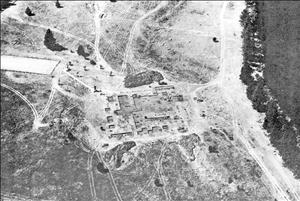In 1810, the Canadian North West Company establishes a fur-trading post called Spokane House where the Little Spokane River joins the Spokane River, about 10 miles downstream from the current location of the city of Spokane in Eastern Washington. Spokane House is the first longterm non-Indian settlement in what is now Washington state. For 16 years it is the headquarters for the fur trade between the Rockies and the Cascades, and a major commercial and social center in the region.
It was the fur trade that first drew non-Indians to the area that is now Washington. Since the 1700s, Spanish, Russian, British, and American ships had been exploring the Northwest coast and trading with the local inhabitants, mostly for furs. Europeans had established outposts elsewhere, such as at Nootka Sound on Vancouver island. However, there were no attempts to settle in what is now Washington, with the exception of a Spanish garrison that in 1792 spent a few months at Neah Bay on the Olympic Peninsula before leaving under pressure from the Makah Indians who lived there.
From House to House
While other traders were arriving by ship, the North West Company was approaching the Pacific Northwest by land in search of furs, primarily beaver. In 1807, under the direction of Canadian explorer and mapmaker David Thompson (1770-1857), head of the company's Columbia Department, the Nor’Westers expanded across the Rocky Mountains into what is now British Columbia, where they established a trading post called Kootanae House. In 1809, they moved south over the future U.S.-Canada border, establishing Kullyspel House on Lake Pend Oreille in present day Idaho and Saleesh House on the "Saleesh" River (now called the Clark Fork) near the current site of Thompson Falls, Montana.
In 1810, Thompson dispatched Jacques Raphael "Jaco" Finlay (1768-1828) to the Spokane River to build a trade house that would serve the Spokane and Colville Indians in present day Eastern Washington. Finlay, son of a Saulteaux woman and an early Nor’Wester, was a company veteran who had worked as clerk, interpreter, and scout, and led the first party of Nor’Westers across the Rockies. He followed what Thompson called the "Skeetshoo Indian Road" (Nisbet, 159) from Lake Pend Oreille southwest to a busy salmon-fishing site on the Spokane River. There, in a pleasant yellow pine flat in the "V" where the Little Spokane meets the Spokane, Finlay, soon joined by fellow Nor’Wester Finan McDonald, built the new post.
Finlay and McDonald had several reasons for choosing this site. It was the headquarters of the middle branch of the Spokane tribe, it was a prime fishing spot for salmon, the large flat was suitable for building, farming, and grazing, and there was a good supply of both timber and game animals nearby. Most of all, however, the Little Spokane was a great beaver stream. It was the pelts of these large rodents that motivated the exploring efforts of the North West Company and most of the other newcomers to the Pacific Northwest.
At this time, all the other merchandise in trade, including horses and guns, was valued in terms of beaver pelts. Prices on an 1824 list from Spokane House ranged from "Scissors" for "½ beaver," to "American rifles" for "30 beaver" (Becher, 39). British guns went for 18 beaver, while "One good horse" cost two pelts. In turn, beaver skins sold in London for two to eight dollars a pound, or in China for four dollars a pelt.
Earliest Settlement in Washington
For 16 years, Spokane House was the center of this fur trade between the Rockies and the Cascades. The post’s establishment in 1810 was a significant milestone in Washington history, because it was the first longterm non-Indian settlement anywhere in present-day Washington or Oregon. It was not until 1811 that American traders from John Jacob Astor’s (1763–1848) Pacific Fur Company founded Astoria, the first permanent settlement in Oregon. In 1812, the Astorians reached the Spokane River and set up a rival post, which they called Fort Spokane, next door to Spokane House. The two posts existed side-by-side for two years until the Astorians sold their Northwest properties including Fort Spokane to the North West Company.
Spokane House was actually a number of buildings, including a store for trading, an office and home for the chief trader, dormitories for the other men, carpenter and blacksmith shops, and a well, probably all enclosed by a stockade. The post, with its fresh garden produce, and its luxuries imported from eastern Canada, such as cured beef, salt pork, flour, rice, biscuits, tea, sugar, and rum, was a very desirable destination for the traders working in the rugged country around.
Spokane House Closes
In 1821, the North West Company was merged into its longtime trading rival, the Hudson’s Bay Company, which took over the operation of all the North West posts, including Spokane House. By that time the beaver streams in the area, which were not extensive, had been exhausted. In addition, Spokane House was 90 miles from the Columbia River, the region’s primary transportation route. Since there was no navigable water connection, this meant a three-day journey by packhorse. In 1824, the Hudson’s Bay Company built Fort Vancouver, on the Columbia at the site of the present city of Vancouver, Washington, and that became the headquarters for all Company trade west of the Rockies. By 1825, Hudson’s Bay decided to close Spokane House and move that post to Kettle Falls on the Columbia River and rename it Fort Colvile.
After the Hudson’s Bay Company abandoned Spokane House, Jaco Finlay, who had founded it, moved onto the site with his Indian wife and their family. Finlay left the North West Company soon after building Spokane House, and was working as an independent trader. He lived with his family at Spokane House until his death in 1828, and is buried there. Finlay had a large family, and has many descendants living in the Spokane area and the inland Northwest.

